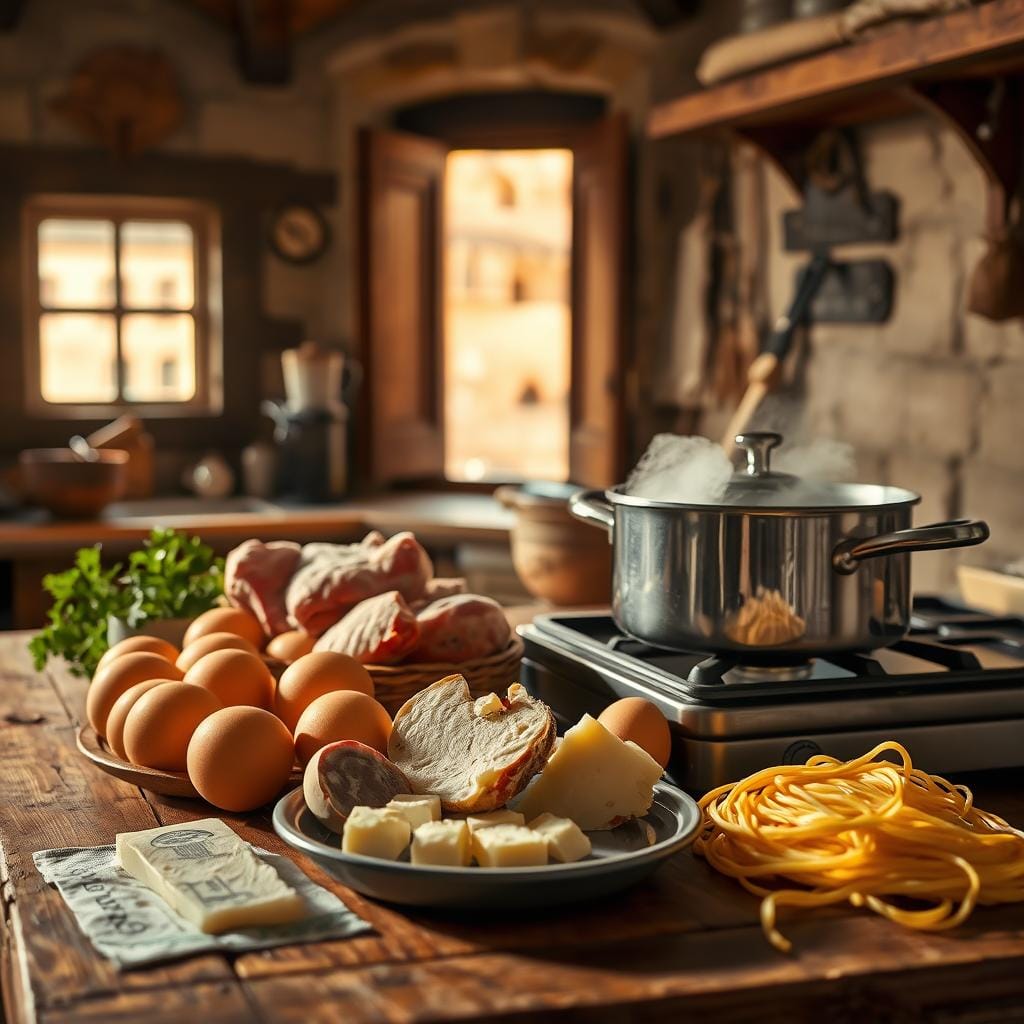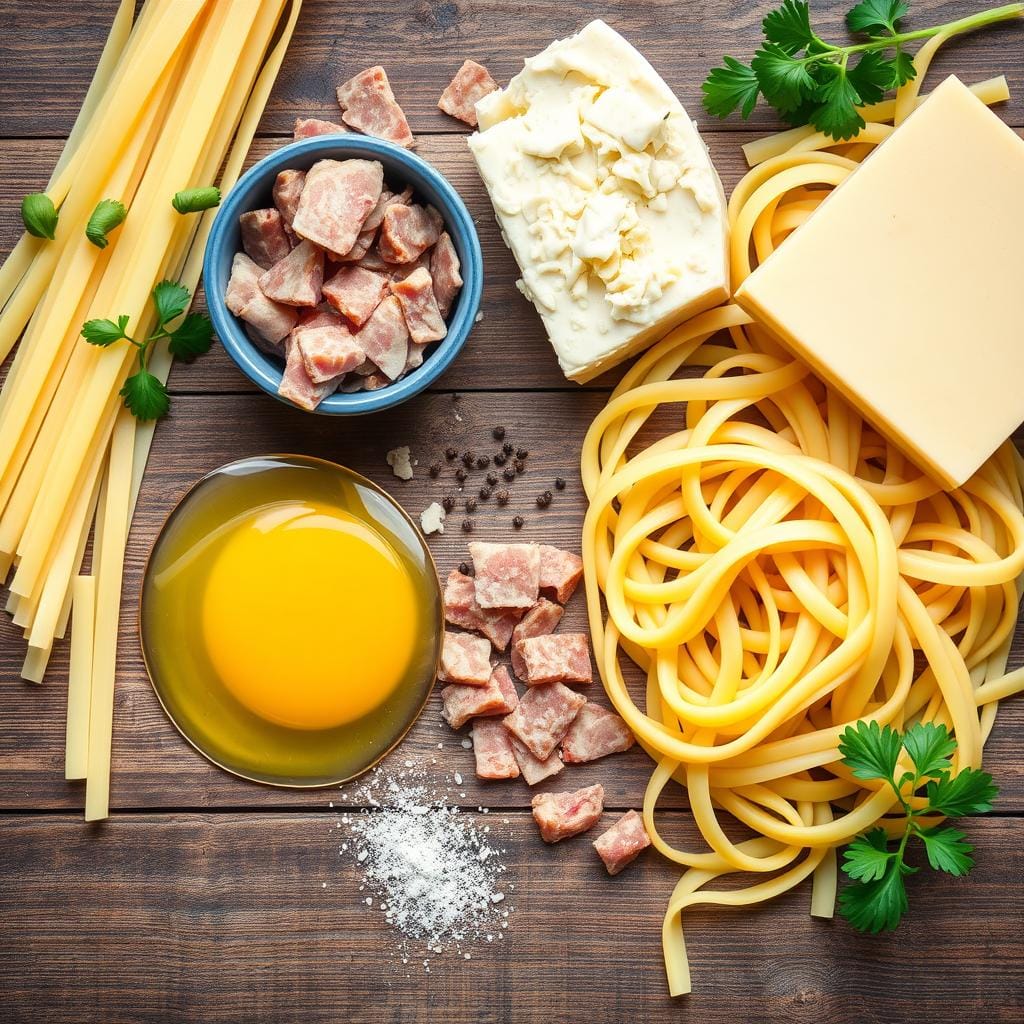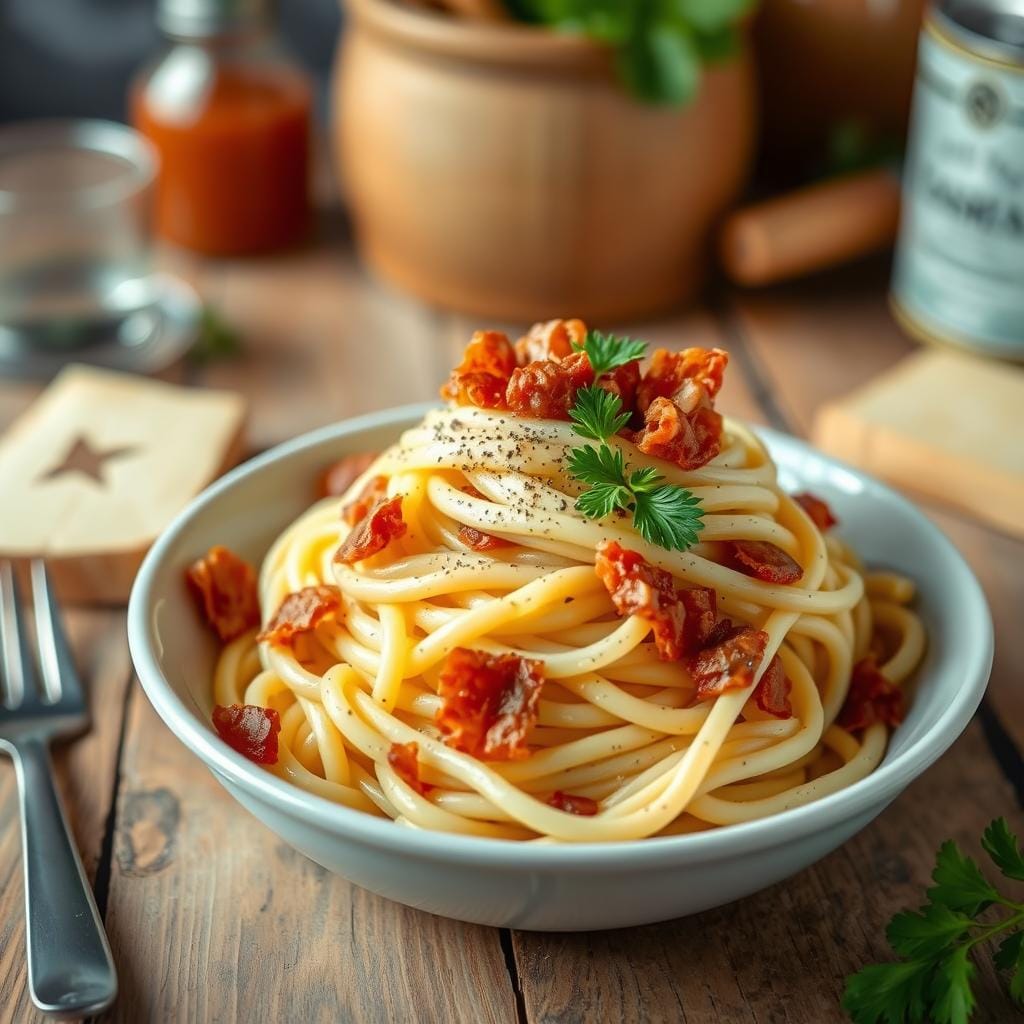Fettuccine carbonara is more than a meal. It’s a tradition in Italian cuisine that tells a story of simplicity and flavor. From Rome’s streets to kitchens worldwide, it charms everyone with its creamy texture and bold flavors.
Start your carbonara journey here. You’ll learn the secrets to making this amazing pasta. It turns simple ingredients into a culinary wonder.
Key Takeaways
- Fettuccine carbonara is a quintessential Roman pasta dish
- The recipe celebrates simple, high-quality ingredients
- Authentic carbonara requires specific traditional techniques
- Each bite tells a story of Italian culinary heritage
- Understanding the dish’s origins enhances appreciation
Understanding the Origins of Fettuccine Carbonara
Explore the rich history of a beloved classic Roman dish. Fettuccine carbonara has a fascinating story that spans decades. It has captured the hearts of food lovers around the world.

The story of carbonara is full of mystery. Food historians have come up with several theories. Each one adds to the dish’s cultural importance.
The Roman Roots of Carbonara
This dish comes from Rome’s heart, showing Italy’s culinary creativity. Stories say it started with charcoal workers. They needed simple, filling meals for long days.
“A dish born from necessity, perfected by passion” – Roman Culinary Tradition
Historical Evolution of the Dish
- 1940s: First documented recipes appear in Rome
- 1950s: Carbonara gains popularity beyond local regions
- 1960s: International recognition begins
- 2000s: Global culinary appreciation peaks
Cultural Significance in Italian Cuisine
Carbonara is more than a meal. It shows the essence of Italian cooking. It’s about simplicity, quality, and family traditions.
| Era | Cultural Impact |
|---|---|
| Early 20th Century | Local Roman specialty |
| Mid 20th Century | Growing national recognition |
| Late 20th Century | International culinary symbol |
Learning about carbonara’s history shows its deep connection to food, history, and culture in Italy.
Essential Ingredients for Authentic Fettuccine Carbonara
To make a real fettuccine carbonara, you need to pick the best ingredients. Each one is important for the dish’s creamy taste. Knowing about these ingredients will help you make a great pasta dish.

Let’s look at the main ingredients that make fettuccine carbonara special:
- Egg Pasta: This is the base of your carbonara. Fresh egg pasta gives it a rich texture and a beautiful color.
- Guanciale: This Italian cured pork cheek adds a deep flavor. It’s salty and essential for a true carbonara.
- Pecorino Romano: This sharp, salty cheese makes the sauce richer. It’s a must-have for carbonara lovers.
- Black Pepper: Freshly ground black pepper adds a spicy touch. It balances the creamy sauce and gives it a unique smell.
Choosing the best ingredients is key to a great carbonara. Using fresh, high-quality items will make your dish stand out.
| Ingredient | Quality Indicators | Recommended Source |
|---|---|---|
| Egg Pasta | Deep yellow color, fresh appearance | Artisan pasta makers, specialty Italian markets |
| Guanciale | Firm texture, rich marbling | Italian delicatessens, specialty meat shops |
| Pecorino Romano | Sharp flavor, granular texture | Cheese specialty stores, imported food sections |
| Black Pepper | Freshly ground, strong aroma | Whole peppercorns, spice merchants |
“In cooking, the quality of ingredients makes all the difference.” – Italian Culinary Tradition
The Art of Selecting Premium Guanciale
Making a real fettuccine carbonara starts with the right guanciale. This cured pork cheek is key to the dish. It adds a special flavor that makes the pasta unforgettable.
Knowing the difference between guanciale and pancetta can make your cooking better. Both are Italian meats, but they taste and feel different. This affects how your carbonara tastes.
Guanciale vs. Pancetta: Know the Difference
- Guanciale comes from the pig’s cheek, offering a richer, more intense flavor
- Pancetta is made from pork belly, with a milder taste and leaner texture
- Traditional carbonara recipes strictly recommend guanciale for authentic results
Sourcing Quality Guanciale in the United States
Finding real guanciale might seem hard, but it’s easier now. Specialty stores and online gourmet shops have great choices. Look for makers who focus on traditional Italian meats.
| Guanciale Buying Tips | What to Look For |
|---|---|
| Color | Deep red with white fat marbling |
| Texture | Firm with visible fat streaks |
| Origin | Preferably Italian-imported or artisan-made |
“The secret to an exceptional carbonara lies in the quality of your guanciale.” – Italian Culinary Experts
When picking your cured pork cheek, choose quality over quick options. A little bit of top-notch guanciale can make your pasta taste like Rome.
Mastering the Perfect Egg-Based Sauce
Making the perfect egg-based sauce for fettuccine carbonara takes skill and precision. It’s all about finding the right balance of ingredients and techniques. You need to control the temperature and how you mix everything.
- Use room temperature eggs for better integration
- Whisk eggs and cheese until completely smooth
- Avoid direct heat when combining ingredients
- Work quickly to prevent curdling
Professional chefs have a special technique for the creamy texture. Begin by whisking egg yolks with Pecorino Romano cheese. The mix should be silky and even, perfect for coating pasta.
“The secret is in the gentle mixing and temperature control” – Italian Cooking Maestro
To mix the egg mixture with hot pasta, take the pan off the heat. Slowly add the eggs while stirring constantly. This keeps the sauce smooth and rich, without scrambling.
With practice and patience, you’ll get the hang of making the best carbonara sauce. Aim for a velvety, glossy finish that makes your dish stand out.
The Role of Pecorino Romano and Parmesan Cheese
Cheese is key to making perfect fettuccine carbonara. The mix of pecorino romano and parmesan cheese makes this dish creamy and flavorful. It’s a favorite among food lovers.
To get the real taste of carbonara, knowing the cheese ratios is important. Chefs suggest a mix that balances pecorino romano’s sharpness with parmesan’s nutty taste.
Crafting the Perfect Cheese Blend
Here are some cheese ratio tips:
- Use 70% pecorino romano for a strong flavor
- Add 30% parmesan for depth and complexity
- Grate the cheese fresh for the best flavor and texture
Mastering Grating Techniques
How you grate cheese matters a lot. Use a microplane or fine grater for fine shavings. This way, the cheese melts well into the sauce. Don’t use pre-grated cheese; it’s better to grate it fresh.
“The secret to exceptional carbonara lies in the quality and preparation of your cheese” – Italian Culinary Experts
Choose high-quality, authentic Italian cheese for your fettuccine carbonara. The right cheese can make your dish go from good to amazing.
Step-by-Step Guide to Making Fettuccine Carbonara
Making fettuccine carbonara needs precision and knowing how to cook pasta. This classic Italian dish might look easy, but it requires careful steps to get it just right.
First, get your ingredients ready and set up your workspace. The secret to a great carbonara is in the timing and how you do it.
- Select high-quality ingredients:
- Fresh fettuccine
- Guanciale or pancetta
- Fresh eggs
- Pecorino Romano cheese
- Freshly ground black pepper
- Prepare the sauce:
- Whisk egg yolks in a large bowl
- Grate Pecorino Romano
- Add black pepper to the mixture
- Cook the pasta:
- Boil water in a large pot
- Salt water generously
- Cook fettuccine until al dente
- Crisp the guanciale:
- Render fat in a skillet
- Cook until golden and crispy
“The magic of carbonara is in its simplicity and technique.” – Italian Cooking Maestro
The key moment in making fettuccine carbonara is mixing the hot pasta with the egg mixture. Take the pasta off the heat and mix it with the sauce. This way, the heat from the pasta cooks the eggs without scrambling them.
By mastering these pasta cooking techniques, you’ll make a carbonara that’s as good as any in a restaurant. It will feel like you’re dining in Rome.
Common Mistakes to Avoid When Cooking Carbonara
Making the perfect fettuccine carbonara needs precision and careful attention. Even skilled home chefs can face challenges that affect the dish’s sauce consistency.
To create a smooth, creamy carbonara, you must understand how to mix delicate ingredients. Beginners often make mistakes that turn this classic Italian dish into a scrambled mess.
Temperature Control: The Critical Factor
Mastering temperature is key when making carbonara. Your sauce can go from silky to chunky if you’re not careful. Here are some temperature control tips:
- Remove pan from direct heat before adding eggs
- Use residual pan warmth to gently cook egg mixture
- Stir continuously to prevent rapid temperature changes
Preventing Sauce Separation
Sauce separation can ruin your carbonara’s luxurious texture. Here are some strategies to keep your sauce perfect:
- Temper eggs by slowly adding hot pasta water
- Mix cheese and eggs before adding to pasta
- Work quickly to blend ingredients
“The secret to great carbonara is patience and technique.” – Italian Chef Mario Batali
By learning these cooking techniques, you’ll make your carbonara extraordinary. You’ll ensure a dish that rivals restaurant quality every time.
Wine Pairing Suggestions for Your Carbonara
Choosing the right wine can make your fettuccine carbonara unforgettable. Italian wines are key to matching the creamy texture and savory flavors of this dish.
For carbonara, look for Italian wines that match its bold taste. The creamy sauce and salty guanciale need wines with certain traits.
- White Wine Options:
- Frascati – A crisp Roman white
- Pinot Grigio from Northern Italy
- Verdicchio – Offers bright acidity
- Red Wine Options:
- Chianti Classico
- Light-bodied Sangiovese
- Barbera d’Asta
Your wine should balance the carbonara’s richness. A creamy sauce goes well with wines that have enough acidity to cut through the fat.
“Wine is the intellectual part of a meal, while meat and vegetables are merely the material.” – Alexandre Dumas
| Wine Type | Flavor Profile | Carbonara Pairing Rating |
|---|---|---|
| Frascati | Crisp, Light | Excellent |
| Chianti Classico | Medium-Bodied, Fruity | Very Good |
| Barbera | Low Tannin, High Acidity | Good |
Remember, your taste is what matters most. Try different Italian wines to find the perfect match for your carbonara.
Modern Variations and Creative Twists
Fettuccine carbonara has grown in popularity, blending new ideas with its classic roots. Chefs and home cooks have found creative ways to make this dish their own. This makes it more varied and fun for everyone.
Vegetarian carbonara has brought new life to the dish, appealing to those who love creamy pasta but don’t eat meat. By using plant-based alternatives instead of guanciale, you can make a tasty vegetarian carbonara. It keeps the dish’s true essence alive.
Innovative Vegetarian Options
- Mushroom-based carbonara using crispy king oyster mushrooms
- Smoked tofu as a protein-rich guanciale replacement
- Roasted eggplant cubes for added texture and depth
Regional Italian Cuisine Interpretations
Italy’s different regions have put their own spin on carbonara, using local ingredients and traditions. From the North’s truffle carbonara to the South’s sun-dried tomato version, each one tells a tasty tale.
| Region | Unique Carbonara Twist | Key Ingredient |
|---|---|---|
| Tuscany | Pecorino-Heavy Carbonara | Aged Pecorino Cheese |
| Sicily | Spicy Carbonara | Calabrian Chili Pepper |
| Liguria | Herb-Infused Carbonara | Fresh Basil |
Trying out these modern takes lets you see how versatile carbonara is. Whether you’re making a vegetarian version or exploring regional flavors, the dish’s core remains the same.
Tips for Storing and Reheating Leftover Carbonara
Keeping your homemade fettuccine carbonara fresh is key. You need to store it right and reheat it carefully. This way, you’ll keep its creamy texture and rich flavor.
Optimal Pasta Storage Methods
- Store carbonara in an airtight container
- Refrigerate within two hours of cooking
- Keep pasta in the refrigerator for no more than 3-4 days
When you store carbonara, try to keep the pasta and sauce separate. This helps the sauce stay creamy. Pro tip: Place a layer of plastic wrap directly on the surface of the sauce to prevent a skin from forming.
Reheating Techniques for Perfect Carbonara
| Reheating Method | Recommended Technique | Tips |
|---|---|---|
| Stovetop | Low heat with splash of milk | Stir constantly to prevent scorching |
| Microwave | 30-second intervals | Add small amount of cream to restore moisture |
“The key to reviving leftover carbonara is gentle heating and careful moisture management.” – Italian Culinary Institute
Don’t reheat carbonara too many times. It can make the sauce lose its quality. When you do reheat, aim for a warm dish without overcooking the eggs.
- Use low, steady heat
- Add a splash of pasta water if sauce appears dry
- Stir frequently to maintain creamy consistency
By using these storage and reheating tips, you can enjoy your leftover carbonara just like it was fresh.
Conclusion
Fettuccine carbonara is a true gem in Italian cuisine. It’s more than just a classic pasta dish. Your journey through this recipe shows how simple ingredients and techniques can make pasta extraordinary.
When making fettuccine carbonara, remember to respect traditional methods but also add your own touch. Using authentic guanciale, fresh eggs, and the right cheeses makes a big difference. It brings you closer to Rome’s culinary heart.
Learning to make this dish takes practice and patience. With each try, you’ll get better at understanding its subtleties. Whether you’re cooking at home or dreaming of being a chef, keep learning and experimenting.
Your adventure with fettuccine carbonara is just starting. Try new variations, improve your skills, and enjoy the delicious outcomes. Your dedication to this Italian classic will pay off.

